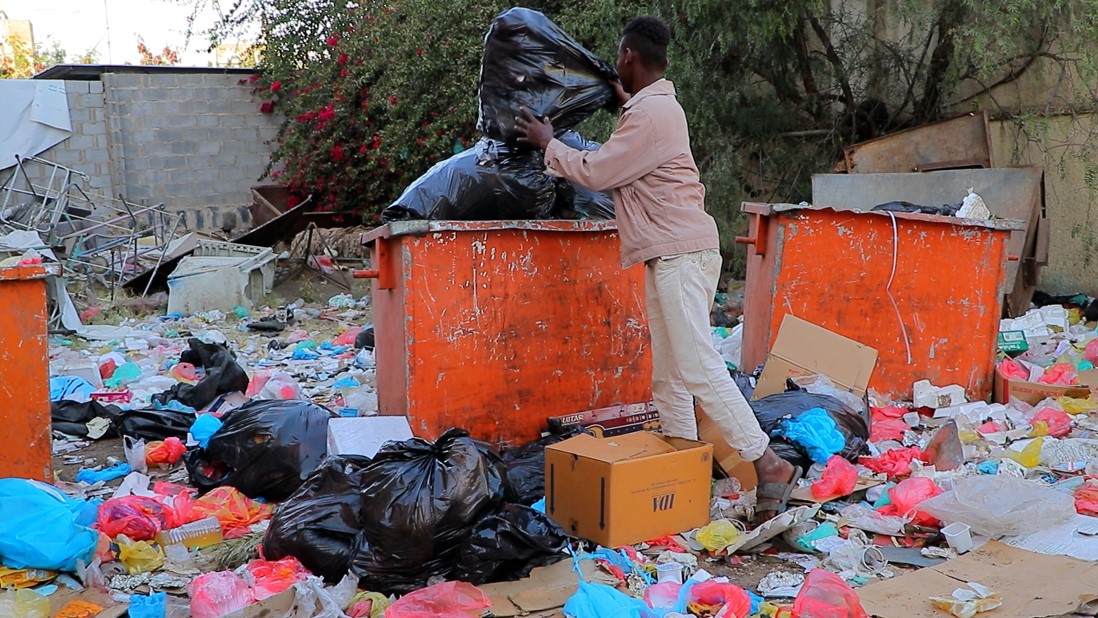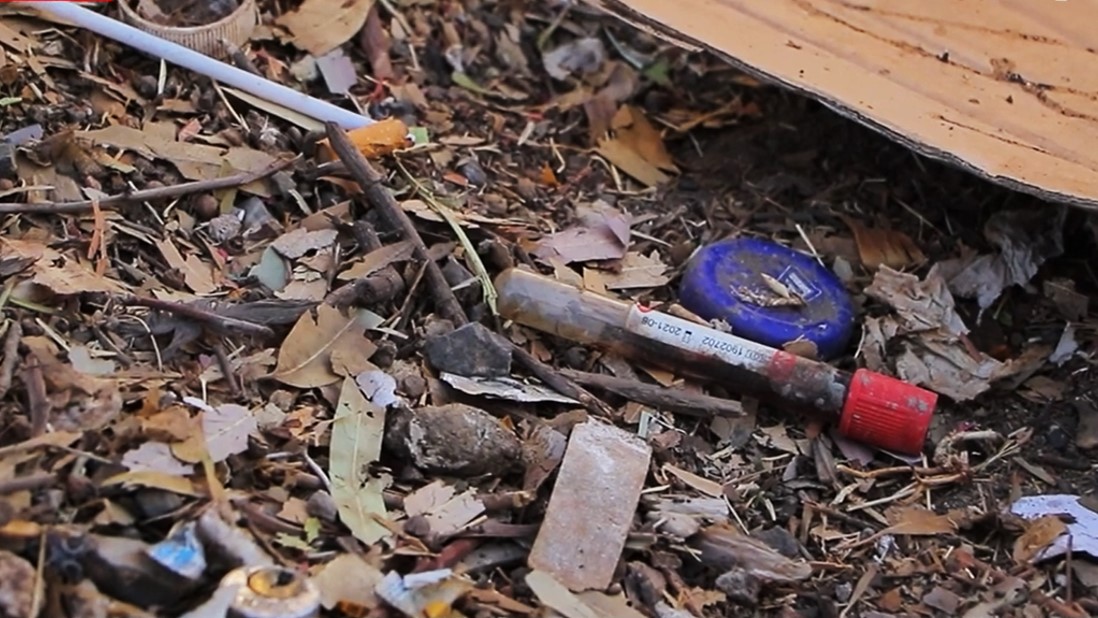By: Holm Akhdar (Sana’a)
Four years ago, Mohammed Al-Zawar (32 years old) stopped working as a garbage truck driver in Sana’a after one of his feet was injured by sharp solid waste while working at the landfill. His health was badly affected, and he had to stop working.
In an interview with Holm Akhdar, Mohammed Al-Zawar said, “The garbage truck broke down, and when I got out to check the problem, my foot got hurt with a sharp piece of glass. As I woke up the second day, my whole body was pale and yellow. I immediately went to the doctor and after I had the required tests done, the doctor told me that it was the beginning of jaundice. About 2-3 years later, my liver cirrhosis stage started!”
“Since then, I have retired and stopped working for cleaning sector, and I receive my pensions from the Social Insurance Authority” added Mohammed.
Medical Waste Mismanagement
Medical waste crisis and Yemen’s mismanagement of its solid waste emerged in 2015, after waste piled up in the streets of the capital and major cities.
Throughout the country, healthcare waste is being mixed with municipal waste when moved to disposal sites, without undergoing any treatment, sorting or disinfection.
Medical waste mismanagement is a reflection of a major problem in the country, and it is the result of a decades-long failure to develop and adopt a national waste management plan, in accordance with sound health and environmental standards.
In 2007, a national plan for healthcare waste management in Yemen was collaboratively devised by the Environmental Protection Agency, the Ministry of Health and Population, and the World Health Organization.
However, due to current circumstances triggered by the ongoing conflict, Yemen does not have the capability to implement a long-term strategic nationwide plan for medical waste management.
Holm Akhdar found that the medical waste management crisis, which has been neglected for decades, has only worsened in recent years and thus affecting the health of the community.
Among such composite crises: the humanitarian crisis, the collapse of 50% of health facilities affected by the war, and poor control by the Ministry of Health – divided between Sana’a and Aden, the medical waste management plan has vanished.


Medical Waste Left Untreated
In June 2015, Sanaa’s sole healthcare waste treatment facility, located separately far from the main waste dumpsite (Al-Azraqain landfill), was badly destroyed by an air strike.
That facility was established in 2014, as a result of an agreement between UNDP Yemen and the Sana’a Cleaning and Improvement Fund. It became operational in March 2015. It had one sanitizer (autoclave) with a volume capacity of 2 cubic meters, and a treatment cycle of 400 kg/hour, plus one washing machine for waste containers, and two trucks designated for transporting HCW from hospitals and medical facilities.
In addition, most medical waste incinerators in local hospitals have ceased to operate due to lack of equipment and the fuel shortage crisis.
Al-Thawra General Hospital, the largest government hospital in Sana’a, with a capacity of 500 beds, had the best modern incinerator for medical waste in the country.
However, an official source at the hospital informed Holm Akhdar that the incinerator stopped working months ago, by court order, after receiving a complaint submitted by some residents near the hospital that it was a cause of pollution to the neighborhood.
Data by the United Nations Office for the Coordination of Humanitarian Affairs (OCHA) in Yemen indicate that about 42% of Yemenis lack adequate and appropriate health facilities, and the percentage of the population’s use of improved health facilities in rural Yemen is about 56%, versus 79% in urban areas.

Injuries among Workers
In Yemen, most medical waste collectors handle garbage manually, without using any personal protective equipment due to low awareness and the prevalence of some misinformation about the danger of medical waste.
Speaking to Holm Akhdar, Dr. Ibtisam Al-Sadiq, the officer of Infection Control Unit at Kuwait University Hospital, in Sana’a, said, “We have many cases recorded in the hospital, either being pricked/injured by medical needles used by patients or affected by the unsafe transportation of medical waste from departments to the central collection point of cleaners.”
“In addition to unsafe cleaning practices of medical waste, solutions and samples used at the laboratory; The failure to wear protective equipment by cleaners plays a significant role in the injuries among the cadre dealing with medical waste”, added Dr. Ibtisam.
Some field studies indicate a high rate of injuries among collectors of medical waste generated by public health institutions in the country.
A study by (Al-Emad, 2011) shows a high rate of injuries among waste collectors, as the rate of injuries during one year in 5 government hospitals in Sana’a was about 28.7%, according to workers’ reports.
Referring to the study findings, most Yemeni hospitals do not segregate medical from non-medical waste, and no budgets allocated for waste management purposes, which caused shortages in medical waste handling equipment and absence of training programs for medical waste collectors on safe handling procedures.
Moreover, about 60% of waste collectors at government hospitals were using trolleys for medical waste disposal, and none of them were cleaned or sterilized after each waste collection process, while 25% of waste collectors at private hospitals were using trolleys to move waste, and only 8.3% of them were cleaned and sterilized after each collection process, which causes infections among health personnel and workers in medical facilities, besides the transmission of some viral diseases. (Al-Emad, 2011)

Medical Waste and Related Health Risks
Medical waste riskiness lies in the fact that it contains many germs and microbes and is capable of spreading many infectious diseases to humans.
Several field studies affirm that hazardous medical waste may be a source of several diseases: AIDS, hepatitis, tuberculosis, and other diseases.
In this regard, Dr. Ibtisam added, “We occasionally record cases of injuries accompanied by the transmission of some infectious viruses, such as the viruses of hepatitis B, hepatitis C and HIB”.
Also, estimates by WHO, show more than 23 million cases of hepatitis B & C and HIV/AIDS infection occur annually in the world, due to unsafe injection practices (non-sterilized reuse of medical needles).
In Yemen, although medical waste is low compared to the Middle East countries, clinical solid waste is still of a serious threat to the population as long as it is being collected together with other solid waste, and not subjected to any treatment before moving it to the disposal site.
Eng. Ali Al-Dhabhani, the Director of Chemical Safety Department- EPA, explained to Holm Akhdar, “Healthcare waste, such as sharp tools, gauze, blood, and surgical waste, are generated in very small quantities, but if not sorted out, they become hazardous and infectious waste”.
“As a result of not sorting out medical waste in hospitals, and transferring it mixed with solid waste to public landfills, waste gets contaminated and turns into a biological bomb! Thus, it affects a large portion of the population” added Al-Dhabhani.

Quantity of Medical Waste Generated
Findings of a study by (Al-Wabr, et al., 2016) demonstrated that the average rate of the total medical waste generation in Sana’a government hospitals was 3 kg/patient/day, and about 2.5 kg/bed/day, and the daily average of the medical waste generated by the four largest government hospitals in Sana’a (Al-Thawra, Al-Kuwait, Aljmhori, and Military) amounted to about 5615 kg/day, and approximately 26% of which was hazardous (infectious, pathogenic, and chemical wastes), while 74% was general (non-hazardous) waste.
Furthermore, based on estimations by the Director of the Chemical Safety Department- EPA, the quantity of medical waste in Sana’a reached 17,000 tons per year.
As for the National Healthcare Waste Management Plan, the quantity of medical waste in Yemen amounted to about 44,769.6 tons in 2016.
According to data provided by the Ministry of Local Administration, Table (1), the amount of solid waste in Yemen’s rural and urban areas increased from 4,376 million tons in 2017 to about 4,609 million tons in 2019.
Regarding dumpsites, recent statistics by the Central Statistics Organization (Seen by Holm Akhdar) indicated that the country’s official solid waste dumpsites rose to about 53 in rural and urban areas in 2019, versus 21 sites in 2015.

Medical Waste and Absence of Protection
Most workers in local hospitals and cleaners are unaware of the potential risks of clinical waste, therefore, they are not found to take requisite protective measures. In most cases, they do not wear plastic aprons, sturdy masks, gloves, and protective shoes while collecting and transporting medical waste from health facilities.
A study by (Efaq and Al-Gheethi, 2015) mentioned that medical waste is collected in black plastic bags, which are not biohazard waste bags (as yellow and red bags).
In 2012-2014, Yemeni health authorities allocated specific vehicles to transport hazardous healthcare waste from hospitals. However, these vehicles are sometimes used to transport garbage waste from streets and neighborhoods, without being cleaned of medical waste.
In open landfills in major Yemeni cities, lack of protection contributes to the presence of garbage pickers who are unaware of its riskiness as being mixed with medical waste. Additionally, with some animals present there, such as stray dogs and goats, the spread of vector-borne diseases is escalated. As a result, the existing health crisis is further exacerbated.
In conclusion, addressing all the issues related to medical waste management, Yemen needs to develop and apply new plans and regulations if good community health protection was to be ensured. Yet, nothing practical can be done soon.

References:
– Yemen Humanitarian Needs Overview, February 2021, OCHA, Yemen.
-Efaq, Numan, and Al-Gheethi, Adel (July 2015). Management of Clinical Solid Wastes Generated from Healthcare Facilities in
Yemen, research paper.
– Al-Emad, Adel, (2011) “Assessment of medical waste management in the main hospitals in Yemen “. Eastern Mediterranean Health Journal (EMHJ) WHO Regional Office, Vol. 17 No. 10.
– GIZ (April 2014). Report “Status of Solid Waste Management in Yemen”.
– Al-Wabr, Jawad et al., (July 2016). Determination of medical waste composition in hospitals of Sana’a city, Yemen, AJOL Journal of Applied Science and Environmental Management, Volume 20(2), pp. 343-347.
